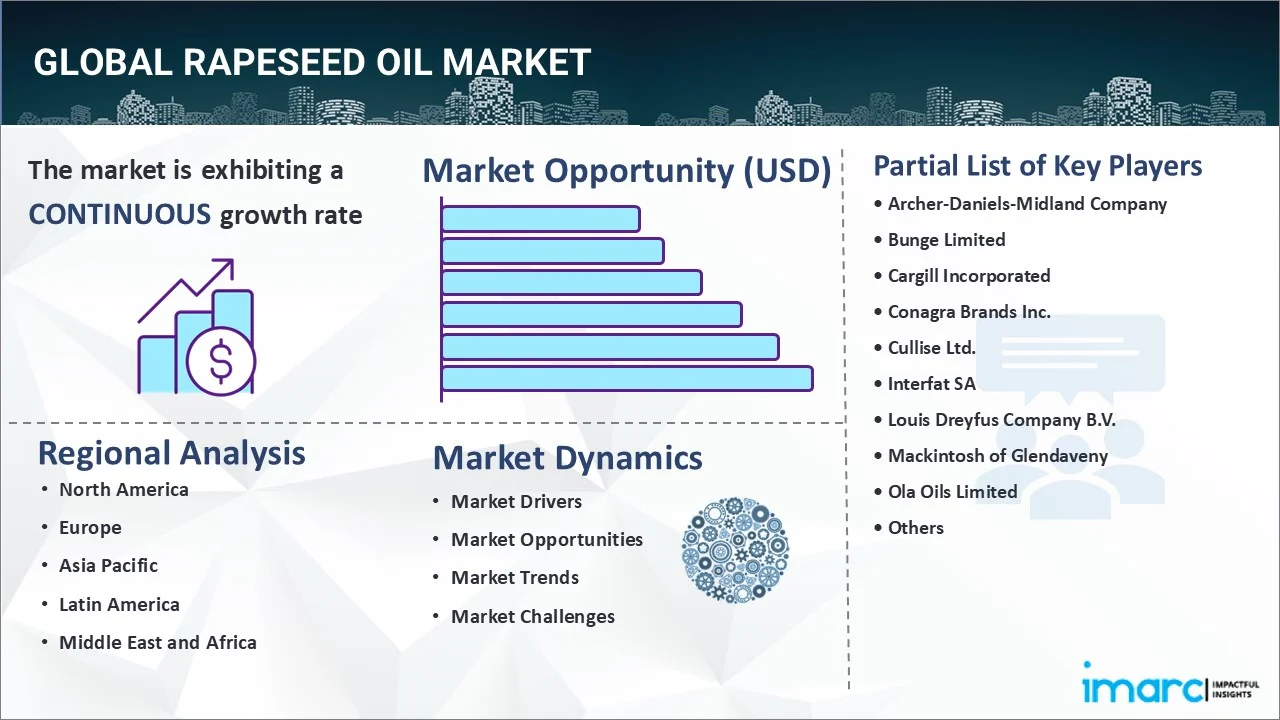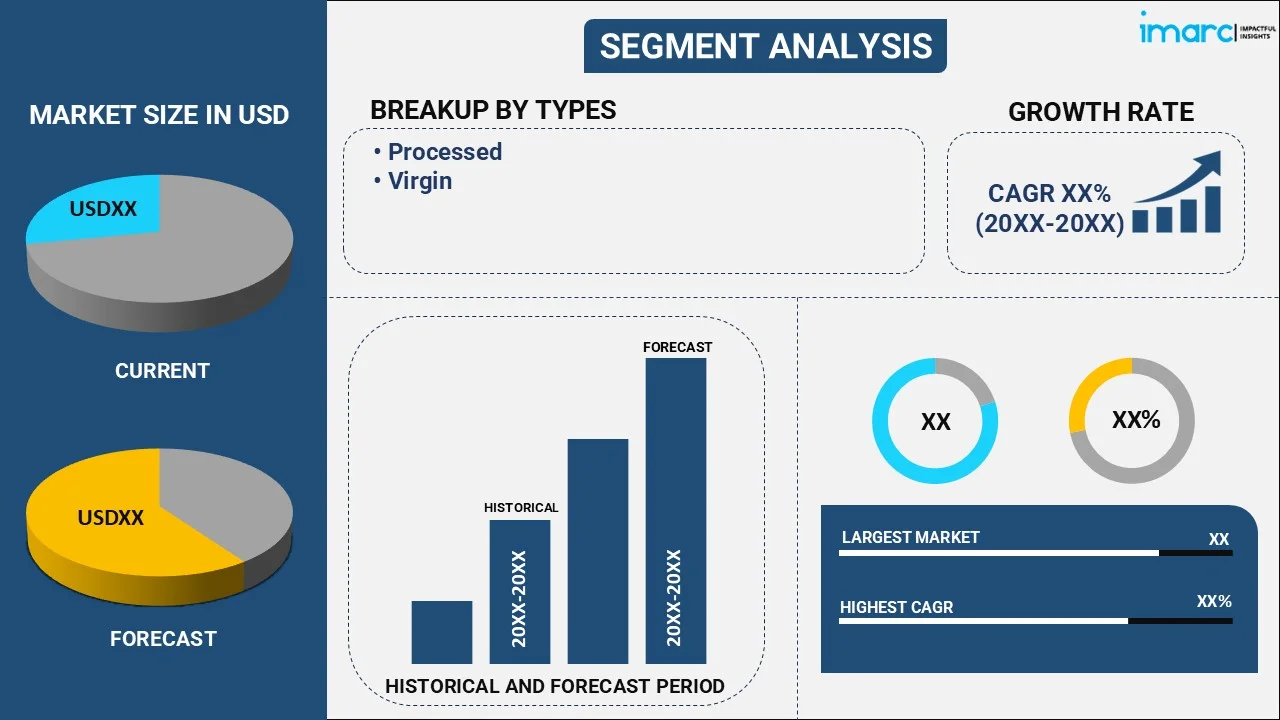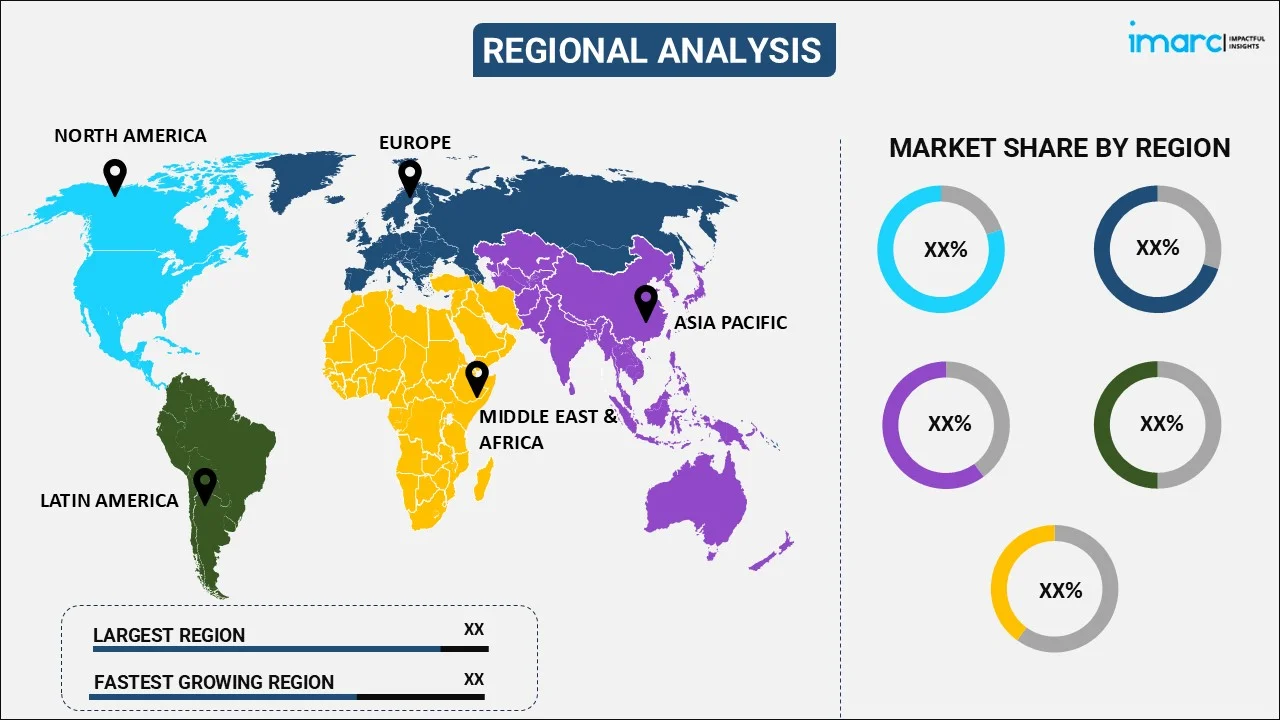
Rapeseed Oil Market Report by Type (Processed, Virgin), Nature (Organic, Conventional), Distribution Channel (Supermarkets and Hypermarkets, Online Stores, Specialty Stores, Retail Stores, and Others), Application (Food Processing, Bio-Fuel, Cosmetics and Personal Care, and Others), and Region 2025-2033
Market Overview:
The global rapeseed oil market size reached USD 37.7 Billion in 2024. Looking forward, IMARC Group expects the market to reach USD 55.9 Billion by 2033, exhibiting a growth rate (CAGR) of 4.44% during 2025-2033. The health-conscious consumers seeking heart-healthy options, its culinary versatility, growing demand for sustainable ingredients, expansion in the food processing sector, and accessibility through retail channels are some of the major factors propelling the market demand.
|
Report Attribute
|
Key Statistics
|
|---|---|
|
Base Year
|
2024 |
|
Forecast Years
|
2025-2033
|
|
Historical Years
|
2019-2024
|
| Market Size in 2024 | USD 37.7 Billion |
| Market Forecast in 2033 | USD 55.9 Billion |
| Market Growth Rate (2025-2033) | 4.44% |
Rapeseed oil is a versatile vegetable oil extracted from the seeds of the rapeseed plant, scientifically known as Brassica napus or Brassica rapa. It is commonly used in cooking and food preparation due to its mild flavor and high smoke point, making it suitable for frying, roasting, and baking. Rapeseed oil is renowned for its heart-healthy profile, being low in saturated fats and rich in monounsaturated and polyunsaturated fats, particularly omega-3 fatty acids. Besides this, it contains vitamin E and other antioxidants, making it beneficial for overall health. Rapeseed oil is a staple in many kitchens, appreciated for its culinary versatility and nutritional benefits.

The global rapeseed oil market is experiencing significant growth due to the increasing consumer awareness of the health benefits associated with its consumption and usage. In line with this, its favorable fatty acid composition, including high levels of monounsaturated and polyunsaturated fats, and omega-3 fatty acids, is fueling the demand for rapeseed oil as a heart-healthy alternative to other cooking oils, appealing to health-conscious consumers. Moreover, the expanding food industry's demand for versatile and high-quality cooking oils is bolstering market growth. In addition to this, rapeseed oil's neutral flavor and high smoke point make it a preferred choice for various culinary applications, from frying to salad dressings, creating a positive outlook for market expansion. Furthermore, the rising adoption of plant-based diets and the growing trend towards natural and minimally processed ingredients are revolutionizing the rapeseed oil market outlook.
Rapeseed Oil Market Trends/Drivers:
Health consciousness and nutritional benefits
One of the primary drivers of the rapeseed oil market is the growing health consciousness among consumers. Rapeseed oil is renowned for its heart-healthy attributes. It contains a favorable fatty acid profile, with low levels of saturated fats and high levels of monounsaturated and polyunsaturated fats, particularly omega-3 fatty acids. Omega-3 fatty acids are known for their role in reducing the risk of cardiovascular diseases and promoting overall well-being. This nutritional profile has made rapeseed oil an attractive choice for health-conscious individuals seeking to improve their dietary habits. As consumers become more aware of the importance of healthy cooking oils, the demand for rapeseed oil continues to rise.
Culinary versatility and cooking performance
Another key rapeseed oil market trend is its exceptional culinary versatility and cooking performance. Rapeseed oil has a mild, neutral flavor that doesn't overpower the taste of dishes, making it suitable for a wide range of culinary applications. Its high smoke point, which is higher than many other vegetable oils, makes it ideal for frying, roasting, and baking, as it can withstand high cooking temperatures without breaking down or producing harmful compounds. This attribute is particularly important for professional chefs and the food service industry, where consistent cooking results and flavor preservation are crucial. Rapeseed oil's ability to cater to various cooking methods and maintain food quality is driving its adoption in both household kitchens and commercial food production.
Plant-based and natural ingredient trends
The global trend towards plant-based diets and a preference for natural, minimally processed ingredients is the third major factor propelling the rapeseed oil market. As more consumers seek alternatives to animal-based products and highly processed oils, rapeseed oil gains prominence. It is derived from the seeds of the rapeseed plant through mechanical extraction and refining processes, which align with the demand for less processed and more natural ingredients. Additionally, rapeseed oil is free from trans fats, making it an appealing choice in an era where consumers are looking to reduce their consumption of harmful fats. This trend is further accentuated by the use of rapeseed oil in the production of various organic and clean-label food products, catering to the preferences of health-conscious and environmentally aware consumers.
Rapeseed Oil Industry Segmentation:
IMARC Group provides an analysis of the key trends in each segment of the global rapeseed oil market report, along with forecasts at the global, regional, and country levels for 2025-2033. Our report has categorized the market based on type, nature, distribution channel, and application.
Breakup by Type:

- Processed
- Virgin
Processed dominates the market
The report has provided a detailed breakup and analysis of the market based on the type. This includes processed and virgin. According to the report, processed represented the largest segment.
Rapeseed oil is a key component in the production of biodiesel, a renewable and environmentally friendly alternative to traditional fossil fuels, which is presenting lucrative opportunities for market growth. As the world seeks sustainable energy solutions and reduced carbon emissions, the biodiesel industry is growing significantly, increasing the need for processed rapeseed oil as a feedstock. In confluence with this, rapeseed oil's versatility makes it valuable in the manufacturing of various industrial products, including lubricants, plastics, and bio-based chemicals, further boosting its demand in non-food sectors.
Breakup by Nature:
- Organic
- Conventional
Conventional holds the largest share in the market
A detailed breakup and analysis of the market based on nature has also been provided in the report. This includes organic and conventional. According to the report, conventional accounted for the largest market share.
The demand for conventional rapeseed oil is driven by its affordability and stability in comparison to some specialty oils. While specialty oils such as avocado or walnut oil offer unique flavors and health benefits, conventional rapeseed oil offers a cost-effective alternative for consumers and food manufacturers without compromising on versatility and performance in various cooking applications, strengthening the market growth. In addition to this, its longer shelf life due to its inherent stability, makes it an attractive choice for budget-conscious consumers and businesses looking for a reliable and economical cooking oil option.
Breakup by Distribution Channel:
- Supermarkets and Hypermarkets
- Online Stores
- Specialty Stores
- Retail Stores
- Others
Supermarkets and hypermarkets dominate the market
The report has provided a detailed breakup and analysis of the market based on the distribution channel. This includes supermarkets and hypermarkets, online stores, specialty stores, retail stores, and others. According to the report, supermarkets and hypermarkets represented the largest segment.
The demand for rapeseed oil in supermarkets and hypermarkets is driven by the growing need for convenience and accessibility among consumers. These large-scale retail outlets offer a wide range of cooking oil options, including rapeseed oil, making it easily available to a broad customer base. Shoppers appreciate the convenience of finding rapeseed oil alongside other household essentials, promoting its regular usage. Moreover, the presence of various packaging sizes and brands in these stores allows consumers to select products that suit their preferences and needs, further impelling the popularity of rapeseed oil as a versatile and readily accessible cooking oil choice.
Breakup by Application:
- Food Processing
- Bio-Fuel
- Cosmetics and Personal Care
- Others
Food processing holds the largest share of the market
A detailed breakup and analysis of the market based on the application has also been provided in the report. This includes food processing, bio-fuel, cosmetics and personal care, and others. According to the report, the food processing sector accounted for the largest market share.
The rapeseed oil’s exceptional functionality and versatility as an ingredient is fueling its demand across the food processing sector. Food processors value rapeseed oil for its ability to enhance the texture, taste, and shelf life of their products, propelling the market forward. It is frequently used in salad dressings, mayonnaise, bakery items, and snack foods, among others, due to its neutral flavor and excellent emulsifying properties. Furthermore, its stable composition under high-temperature processing and the absence of trans fats aligns with the industry's focus on producing healthier, minimally processed, and longer-lasting food products, further increasing its demand in food processing applications.
Breakup by Region:

- North America
- United States
- Canada
- Asia-Pacific
- China
- Japan
- India
- South Korea
- Australia
- Indonesia
- Others
- Europe
- Germany
- France
- United Kingdom
- Italy
- Spain
- Russia
- Others
- Latin America
- Brazil
- Mexico
- Others
- Middle East and Africa
Asia-Pacific exhibits a clear dominance, accounting for the largest rapeseed oil market share
The market research report has also provided a comprehensive analysis of all the major regional markets, which include North America (the United States and Canada); Asia Pacific (China, Japan, India, South Korea, Australia, Indonesia, and others); Europe (Germany, France, the United Kingdom, Italy, Spain, Russia, and others); Latin America (Brazil, Mexico, and others); and the Middle East and Africa. According to the report, Asia-Pacific accounted for the largest market share.
The Asia Pacific region's rising population and increasing disposable income levels have resulted in higher consumption of edible oils, with rapeseed oil gaining popularity due to its perceived health benefits. Additionally, the region's expanding food processing industry, driven by changing consumer lifestyles and preferences, is boosting demand for rapeseed oil as a versatile ingredient in various processed foods. Furthermore, the growing awareness of the environmental impact of oil production has led to increased adoption of sustainable and locally sourced rapeseed oil, aligning with the sustainability goals of both consumers and businesses, creating a positive outlook for market expansion. Apart from this, the diversification of distribution channels, including e-commerce platforms, is making rapeseed oil more accessible to a broader audience, further contributing to its growth in the Asia Pacific region.
Competitive Landscape:
The competitive landscape of the global rapeseed oil market is characterized by a mix of multinational corporations, regional players, and small-scale producers. Leading companies dominate the market, leveraging their extensive distribution networks and economies of scale. These giants invest heavily in research and development to improve product quality, sustainability, and expand their product lines to cater to diverse consumer preferences. Furthermore, sustainability initiatives have gained prominence, leading to increased adoption of sustainable and certified rapeseed oil, further benefiting well-established players with the resources to meet these demands. Additionally, the market has seen the emergence of smaller boutique brands that target health-conscious consumers with premium, cold-pressed, or organic rapeseed oil options.
The report has provided a comprehensive analysis of the competitive landscape in the market. Detailed profiles of all major companies have also been provided. Some of the key players in the market include:
- Archer-Daniels-Midland Company
- Bunge Limited
- Cargill Incorporated
- Conagra Brands Inc.
- Cullise Ltd.
- Interfat SA
- Louis Dreyfus Company B.V.
- Mackintosh of Glendaveny
- Ola Oils Limited
- Yorkshire Rapeseed Oil
Rapeseed Oil Market Recent Developments:
- October 2024: The ORLEN Group announced plans to construct a hydrotreated vegetable oil (HVO) production plant with an annual capacity of 300,000 tons of finished biocomponents. The plant will be processing a range of lipid feedstocks, including rapeseed oil, used cooking oil, and their blends
- July 2024: Cargill announced that it has surpassed the 50% completion milestone for its new canola (rapeseed) processing facility in Regina, Saskatchewan. This facility is designed to enhance the company's capacity to meet growing demand for canola oil and protein meal. The facility is expected to be operational by 2025, further solidifying Cargill's position in the canola market.
Rapeseed Oil Mxarket Report Scope:
| Report Features | Details |
|---|---|
| Base Year of the Analysis | 2024 |
| Historical Period | 2019-2024 |
| Forecast Period | 2025-2033 |
| Units | Billion USD |
| Scope of the Report | Exploration of Historical Trends and Market Outlook, Industry Catalysts and Challenges, Segment-Wise Historical and Predictive Market Assessment:
|
| Types Covered | Processed, Virgin |
| Natures Covered | Organic, Conventional |
| Distribution Channels Covered | Supermarkets and Hypermarkets, Online Stores, Specialty Stores, Retail Stores, Others |
| Applications Covered | Food Processing, Bio-Fuel, Cosmetics and Personal Care, Others |
| Regions Covered | Asia Pacific, Europe, North America, Latin America, Middle East and Africa |
| Countries Covered | United States, Canada, Germany, France, United Kingdom, Italy, Spain, Russia, China, Japan, India, South Korea, Australia, Indonesia, Brazil, Mexico |
| Companies Covered | Archer-Daniels-Midland Company, Bunge Limited, Cargill Incorporated, Conagra Brands Inc., Cullise Ltd., Interfat SA, Louis Dreyfus Company B.V., Mackintosh of Glendaveny, Ola Oils Limited, Yorkshire Rapeseed Oil, etc. |
| Customization Scope | 10% Free Customization |
| Post-Sale Analyst Support | 10-12 Weeks |
| Delivery Format | PDF and Excel through Email (We can also provide the editable version of the report in PPT/Word format on special request) |
Key Benefits for Stakeholders:
- IMARC’s report offers a comprehensive quantitative analysis of various market segments, historical and current market trends, market forecasts, and dynamics of the rapeseed oil market from 2019-2033.
- The research study provides the latest information on the market drivers, challenges, and opportunities in the global rapeseed oil market.
- The study maps the leading as well as the fastest growing regional markets. It further enables stakeholders to identify the key country-level markets within each region.
- Porter's five forces analysis assist stakeholders in assessing the impact of new entrants, competitive rivalry, supplier power, buyer power, and the threat of substitution. It helps stakeholders to analyze the level of competition within the rapeseed oil industry and its attractiveness.
- Competitive landscape allows stakeholders to understand their competitive environment and provides an insight into the current positions of key players in the market.
Key Questions Answered in This Report
The global rapeseed oil market was valued at USD 37.7 Billion in 2024.
We expect the global rapeseed oil market to exhibit a CAGR of 4.44% during 2025-2033.
The rising consumer awareness towards numerous associated health benefits of using rapeseed oil, such as improving digestion and gallbladder function, reducing cholesterol levels, lowering risks of cardiovascular diseases, etc., is primarily driving the global rapeseed oil market.
The sudden outbreak of the COVID-19 pandemic has led to the changing consumer inclination from conventional brick-and-mortar distribution channels towards online retail platforms for the purchase of rapeseed oil.
Based on the type, the global rapeseed oil market has been divided into processed and virgin, where processed currently exhibits a clear dominance in the market.
Based on the nature, the global rapeseed oil market can be categorized into organic and conventional. Currently, conventional accounts for the majority of the global market share.
Based on the distribution channel, the global rapeseed oil market has been segregated into supermarkets and hypermarkets, online stores, specialty stores, retail stores, and others. Among these, supermarkets and hypermarkets currently hold the largest market share.
Based on the application, the global rapeseed oil market can be bifurcated into food processing, bio-fuel, cosmetics and personal care, and others. Currently, the food processing sector exhibits a clear dominance in the market.
On a regional level, the market has been classified into North America, Asia-Pacific, Europe, Latin America, and Middle East and Africa, where Asia-Pacific currently dominates the global market.
Some of the major players in the global rapeseed oil market include Archer-Daniels-Midland Company, Bunge Limited, Cargill Incorporated, Conagra Brands Inc., Cullise Ltd., Interfat SA, Louis Dreyfus Company B.V., Mackintosh of Glendaveny, Ola Oils Limited, and Yorkshire Rapeseed Oil.
Need more help?
- Speak to our experienced analysts for insights on the current market scenarios.
- Include additional segments and countries to customize the report as per your requirement.
- Gain an unparalleled competitive advantage in your domain by understanding how to utilize the report and positively impacting your operations and revenue.
- For further assistance, please connect with our analysts.

 Inquire Before Buying
Inquire Before Buying
 Speak to an Analyst
Speak to an Analyst
 Request Brochure
Request Brochure
 Request Customization
Request Customization



.webp)




.webp)












